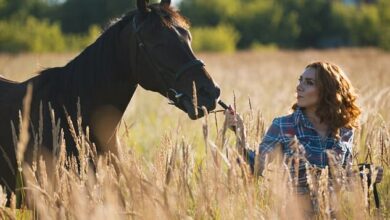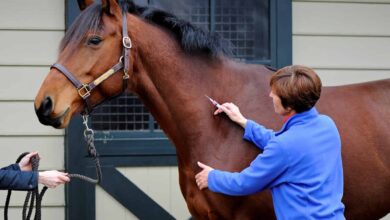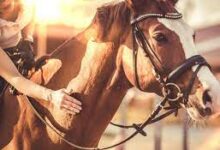Many of the natural horsemanship techniques use human body language, and they rely on the human having knowledge about the horse‟s body language. Even if following traditional training methods it is useful to know what the signs a horse is expressing might mean. It is good to know when a horse is giving very subtle signs that it is uncomfortable, or that it is relaxed and in a frame of mind that enables learning to take place. A horse will usually begin by giving subtle signals of discomfort, but if these are ignored then the behaviour may escalate and become worse.
Signs that may indicate discomfort or unease
Breathing Pattern – A healthy and comfortable horse should breathe in a slow, rhythmic manner. An increase in respiration rate may indicate that a horse is anxious, although obviously it could mean that the horse has been physically exerting himself so this must be taken into account.
Head Positioning – A relaxed horse at leisure will generally keep his head low or keep his neck muscles relatively loose. If the horse stiffens his neck muscles and raises his head, it means that something has caught his attention or caused concern. The degree of stiffness will determine whether the horse is being attentive or cautious.
Pinned Ears – When a horse pins his ears he is seriously angered or concerned and it is a warning sign telling you to back off. Slightly drawn back ears are not the same as ears that are flat against the head though. Flattened ears can indicate anger, but ears that are slightly drawn back may mean he is listening to a sound coming from behind, and may not have a negative meaning at all.
Tail Swishing – When a horse becomes agitated he will often swish his tail back and forth. Depending on the season and location, a tail swish may not indicate annoyance with your request; it may be a reaction to flies. It can be a sign of discomfort.
Tense Muscles – Just as with humans, a horse will stiffen or bunch up his back, neck and leg muscles if he anticipates potential trouble. This a reflex action designed to prepare them for possible flight. Under saddle, tensed muscles can also indicate physical discomfort as the horse may be bracing himself against pain.
Grinding Teeth – If the horse is grinding his teeth then it means he is clearly distressed or unhappy. When the horse grinds his teeth without a bit in the mouth then it is a sign of temper. If a bit is in the mouth this can indicate discomfort.
Foot Raising – A horse that is relaxing will often rest one of his rear feet, letting the tip just brush the floor. This is a good sign, but if the horse actually lifts his rear leg off the floor and his leg appears tense, or it is kept suspended in the air for more than a brief moment, then this could be a sign that he is about to kick.
Fidgeting – A horse that sways his rear end backwards and forwards may be indicating boredom, but it can also be a way to release nervous tension. In either case, such behaviour indicates the horse‟s attention is not directed towards the trainer.
Fast Starts – If your horse takes off under saddle as soon as you have mounted, then this can be a sign of discomfort. A calm horse will begin at a leisurely walk and graduate to higher speeds as you request, while a nervous horse will bolt forward.
The above signs are just some of the most obvious and general reactions that most horses exhibit, although it should be remembered that they are all individuals and it is necessary to get to know the specific behaviour that your own horse displays.
It is also important to get to know the signs of positive body language. These can indicate that a training session is going well, and that the horse is comfortable, both physically and mentally. By observing a horse for positive reactions it allows the trainer to hold back from pushing an unprepared horse too soon, and the trainer can wait until the horse is ready to progress to the next stage.








